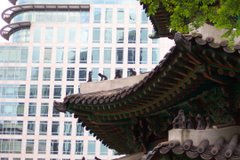In honor of tonight's class (which I will be leading) and in the process of trying to figure out who the authors are, I came across discussion of the first Koguryo history conference held in the United States, at the Harvard University Korea Institute in 2005. The author of our Korea.net readings, So Gil-su spoke there on Korean fortresses. Yes, fortresses, which are apparently a very controversial topic between the Chinese and Koreans. This article discusses the conference, and gives some more examples of how the history is contested. Competition seems to be fierce between the Chinese and the Koreas over whether or not fortresses and other historical sites are independent or resemble those in China. It also gives an idea of who studies this topic, including not only Korean and Chinese scholars but also Japanese, Americans, and Australians.
It was interesting to note that the author, who is certainly on the Korean side in the debates, believes that Western scholars are missing knowledge about Koguryo. I wonder, from the perspective of Western scholars, if they are actually missing information or simply less invested and less biased on the topic. The author's desire to "internationalize" the history of Koguryo is, I would imagine, an effort to legitimize it. If it is international, if they can get the American academic system or the European academic system behind it, supporting its positions on Koguryo, it would certainly lend weight to Korean arguments over Chinese. Despite the author's attempts to balance it and acknowledge a broader perspective than the purely nation-state focused one that we discussed last class, he still, in the end, says something that reminds me of propaganda: "The conference participants thus came to acknowledge that Goguryeo history is part of Korean history based on the evidence presented by the South Korean academics." Really? Did they? Even the Chinese? I am skeptical, but it is an interesting discussion of the international aspects of Koguryo history, as we will be discussing them tonight.
This notice from 2004 is also interesting, pointing out that Korean society considers the claiming of Koguryo as its history important enough to have corporations and volunteers get together to fund publication of a pamphlet in four languages, and then place that pamphlet in locations like embassies and tourist stations.
Wednesday, February 21, 2007
Subscribe to:
Post Comments (Atom)

No comments:
Post a Comment